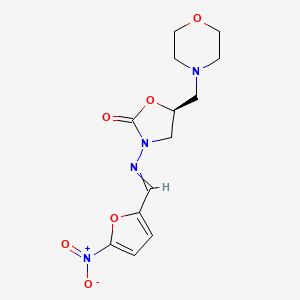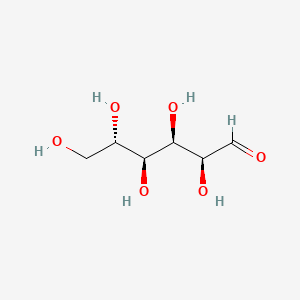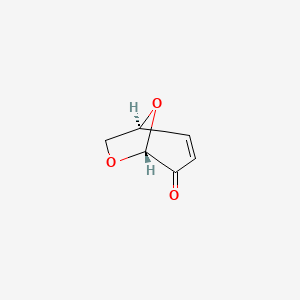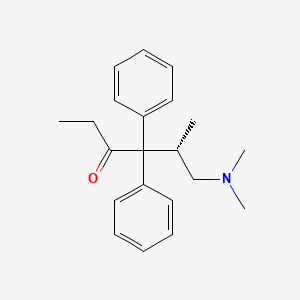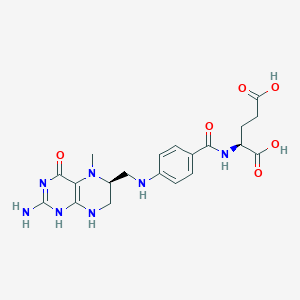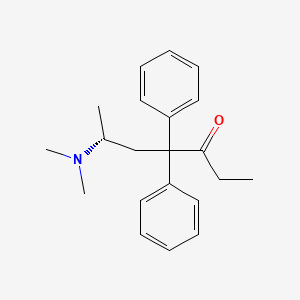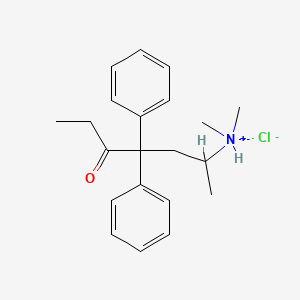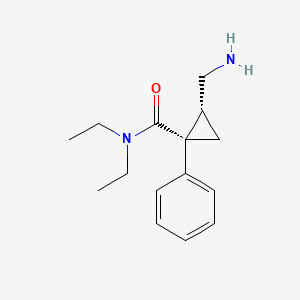
Lévothyroxine
Vue d'ensemble
Description
La lévothyroxine, également connue sous le nom de L-thyroxine, est une forme synthétique de l'hormone thyroïdienne thyroxine (T4). Elle est principalement utilisée pour traiter la carence en hormone thyroïdienne (hypothyroïdie), y compris les formes sévères telles que le coma myxœdémateux. La this compound est également utilisée pour traiter et prévenir certains types de tumeurs thyroïdiennes . Elle est disponible sous diverses formes, notamment des comprimés oraux, des injections intraveineuses et des solutions liquides .
Applications De Recherche Scientifique
La lévothyroxine a un large éventail d'applications en recherche scientifique :
Chimie : Utilisé comme composé de référence en chimie analytique pour le développement de nouvelles méthodes analytiques.
Biologie : Étudié pour son rôle dans la régulation du métabolisme et de la croissance chez divers organismes.
Médecine : Largement utilisé dans le traitement de l'hypothyroïdie et comme thérapie suppressive pour les tumeurs thyroïdiennes.
Industrie : Employé dans l'industrie pharmaceutique pour la production de thérapies de remplacement de l'hormone thyroïdienne.
5. Mécanisme d'action
La this compound exerce ses effets en remplaçant l'hormone thyroïdienne normalement produite par la glande thyroïde. Elle est convertie en triiodothyronine (T3) dans les tissus périphériques, qui se lie ensuite aux récepteurs de l'hormone thyroïdienne dans le noyau des cellules. Cette liaison active la transcription des gènes et la synthèse des protéines, conduisant à une augmentation du métabolisme, de la croissance et du développement . Les principales cibles moléculaires sont les récepteurs de l'hormone thyroïdienne, et les voies impliquées comprennent la régulation des processus métaboliques et la dépense énergétique .
Mécanisme D'action
Target of Action
Levothyroxine (LT4) is a synthetic form of thyroxine, a major endogenous hormone secreted by the thyroid gland . The primary target of LT4 is the thyroid-stimulating hormone (TSH), which is released by the pituitary gland . TSH stimulates the thyroid gland to produce and secrete T4, which is then converted into its active metabolite, triiodothyronine (T3) .
Mode of Action
Levothyroxine acts by mimicking the actions of the natural thyroid hormone, thyroxine (T4). Once administered, it is converted into T3, the more active thyroid hormone, by deiodinases in peripheral tissues . T3 acts in the body to increase basal metabolic rate, alter protein synthesis, and increase the body’s sensitivity to catecholamines (such as adrenaline) .
Biochemical Pathways
The regulation of thyroid hormones within the hypothalamic-pituitary-thyroid (HPT) axis is complex, consisting of multiple feedback and feed-forward loops . In response to Thyroid Stimulating Hormone (TSH) release by the pituitary gland, a normally functioning thyroid gland will produce and secrete T4, which is then converted through deiodination into its active metabolite T3 . T3 exerts the majority of the physiological effects of the thyroid hormones .
Pharmacokinetics
The bioavailability of LT4 is about 70% following an oral dose, with absorption occurring mainly in the ileum and jejunum . Maximum plasma concentrations of LT4 are achieved about 3 hours after an oral dose in patients with hypothyroidism . The long terminal half-life of orally administered LT4, about 7.5 days, is consistent with once-daily dosing .
Result of Action
The effects of LT4 replacement therapy for people with hypothyroidism must be considered within this context, as many patients will have residual thyroid activity . LT4 replacement reverses many metabolic disturbances associated with hypothyroidism including resetting of reduced energy expenditure and metabolic rate, correction of dyslipidaemia, improvement in insulin sensitivity and glycaemic control, and reversal of a pro-inflammatory and procoagulant state .
Action Environment
Several factors can influence the action, efficacy, and stability of LT4. These include pharmaceutical, pathophysiological, and behavioural factors influencing the absorption, distribution, metabolism, and excretion of LT4 . Any factor that alters the state of the epithelium in the stomach or small intestine will reduce and/or slow absorption of LT4 . These include ulcerative colitis, coeliac disease, bariatric surgery, Helicobacter pylori infection, food intolerance, gastritis, mineral supplements, dietary fibre, resins, and various drugs .
Analyse Biochimique
Biochemical Properties
Levothyroxine plays a crucial role in various biochemical reactions. It interacts with numerous enzymes, proteins, and other biomolecules . The regulation of thyroid hormones within the hypothalamic-pituitary-thyroid axis is complex, consisting of multiple feedback and feed-forward loops .
Cellular Effects
Levothyroxine influences various types of cells and cellular processes. It impacts cell function, including effects on cell signaling pathways, gene expression, and cellular metabolism . Levothyroxine replacement therapy for people with hypothyroidism reverses many metabolic disturbances associated with hypothyroidism .
Molecular Mechanism
Levothyroxine exerts its effects at the molecular level through binding interactions with biomolecules, enzyme inhibition or activation, and changes in gene expression . Exogenous Levothyroxine is indistinguishable from endogenous T4 .
Temporal Effects in Laboratory Settings
The effects of Levothyroxine change over time in laboratory settings. Information on the product’s stability, degradation, and any long-term effects on cellular function observed in in vitro or in vivo studies is currently being researched .
Dosage Effects in Animal Models
The effects of Levothyroxine vary with different dosages in animal models. Studies are ongoing to determine any threshold effects observed in these studies, as well as any toxic or adverse effects at high doses .
Metabolic Pathways
Levothyroxine is involved in various metabolic pathways, interacting with enzymes or cofactors. It also affects metabolic flux or metabolite levels .
Transport and Distribution
Levothyroxine is transported and distributed within cells and tissues. It interacts with transporters or binding proteins, affecting its localization or accumulation .
Subcellular Localization
The subcellular localization of Levothyroxine and its effects on activity or function are areas of active research. This includes any targeting signals or post-translational modifications that direct it to specific compartments or organelles .
Méthodes De Préparation
Voies de synthèse et conditions de réaction : La lévothyroxine peut être synthétisée par diverses méthodes. Une méthode courante implique l'iodation de la 3,5-diiodothyronine. Ce processus comprend la déméthylation de l'acide 2-amino-3-(3,5-diiodo-4-(4-méthoxyphénoxy)phényl)propanoïque en utilisant un mélange d'acide acétique et d'acide iodhydrique pour donner de la 3,5-diiodothyronine, qui est ensuite iodée pour produire de la this compound .
Méthodes de production industrielle : La production industrielle de this compound implique des processus en plusieurs étapes pour garantir un rendement élevé et une pureté optimale. Une méthode comprend l'utilisation de groupes protecteurs dans l'ester éthylique de (S)-N-acétyl-3,5-diiodo-4-p-méthoxyphénoxyphénylalanine, qui sont clivés en utilisant un mélange d'acide iodhydrique et d'acide bromhydrique pour donner de la 3,5-diiodothyronine. L'iodation subséquente avec de l'iode produit de la this compound avec un rendement d'environ 92 % .
Analyse Des Réactions Chimiques
Types de réactions : La lévothyroxine subit diverses réactions chimiques, notamment:
Oxydation : La this compound peut être oxydée pour former différents dérivés.
Réduction : Les réactions de réduction peuvent modifier les atomes d'iode dans la molécule.
Substitution : Des réactions de substitution peuvent se produire au niveau du groupe hydroxyle phénolique ou du groupe amino.
Réactifs et conditions courants :
Oxydation : Les agents oxydants courants comprennent le peroxyde d'hydrogène et l'iode.
Réduction : Des agents réducteurs tels que le borohydrure de sodium peuvent être utilisés.
Substitution : Des réactifs comme les halogénures d'alkyle et les chlorures d'acyle sont couramment utilisés pour les réactions de substitution.
Principaux produits formés :
Oxydation : Dérivés oxydés de la this compound.
Réduction : Formes réduites de la this compound avec moins d'atomes d'iode.
Substitution : Dérivés substitués avec différents groupes fonctionnels.
Comparaison Avec Des Composés Similaires
La lévothyroxine est souvent comparée à d'autres hormones thyroïdiennes et analogues synthétiques :
Triiodothyronine (T3) : La this compound (T4) est convertie en triiodothyronine (T3) dans l'organisme.
Liothyronine : Une forme synthétique de T3, utilisée pour l'apparition rapide de l'action chez les patients hypothyroïdiens.
Extrait thyroïdien desséché : Contient à la fois T4 et T3 dans un rapport qui diffère de la sécrétion thyroïdienne humaine.
La this compound est unique en raison de sa stabilité, de sa longue demi-vie et de sa capacité à fournir des niveaux constants d'hormone thyroïdienne avec une dose unique par jour .
Propriétés
IUPAC Name |
(2S)-2-amino-3-[4-(4-hydroxy-3,5-diiodophenoxy)-3,5-diiodophenyl]propanoic acid | |
|---|---|---|
| Source | PubChem | |
| URL | https://pubchem.ncbi.nlm.nih.gov | |
| Description | Data deposited in or computed by PubChem | |
InChI |
InChI=1S/C15H11I4NO4/c16-8-4-7(5-9(17)13(8)21)24-14-10(18)1-6(2-11(14)19)3-12(20)15(22)23/h1-2,4-5,12,21H,3,20H2,(H,22,23)/t12-/m0/s1 | |
| Source | PubChem | |
| URL | https://pubchem.ncbi.nlm.nih.gov | |
| Description | Data deposited in or computed by PubChem | |
InChI Key |
XUIIKFGFIJCVMT-LBPRGKRZSA-N | |
| Source | PubChem | |
| URL | https://pubchem.ncbi.nlm.nih.gov | |
| Description | Data deposited in or computed by PubChem | |
Canonical SMILES |
C1=C(C=C(C(=C1I)OC2=CC(=C(C(=C2)I)O)I)I)CC(C(=O)O)N | |
| Source | PubChem | |
| URL | https://pubchem.ncbi.nlm.nih.gov | |
| Description | Data deposited in or computed by PubChem | |
Isomeric SMILES |
C1=C(C=C(C(=C1I)OC2=CC(=C(C(=C2)I)O)I)I)C[C@@H](C(=O)O)N | |
| Source | PubChem | |
| URL | https://pubchem.ncbi.nlm.nih.gov | |
| Description | Data deposited in or computed by PubChem | |
Molecular Formula |
C15H11I4NO4 | |
| Source | PubChem | |
| URL | https://pubchem.ncbi.nlm.nih.gov | |
| Description | Data deposited in or computed by PubChem | |
DSSTOX Substance ID |
DTXSID8023214 | |
| Record name | Levothyroxine | |
| Source | EPA DSSTox | |
| URL | https://comptox.epa.gov/dashboard/DTXSID8023214 | |
| Description | DSSTox provides a high quality public chemistry resource for supporting improved predictive toxicology. | |
Molecular Weight |
776.87 g/mol | |
| Source | PubChem | |
| URL | https://pubchem.ncbi.nlm.nih.gov | |
| Description | Data deposited in or computed by PubChem | |
Physical Description |
Solid | |
| Record name | Thyroxine | |
| Source | Human Metabolome Database (HMDB) | |
| URL | http://www.hmdb.ca/metabolites/HMDB0000248 | |
| Description | The Human Metabolome Database (HMDB) is a freely available electronic database containing detailed information about small molecule metabolites found in the human body. | |
| Explanation | HMDB is offered to the public as a freely available resource. Use and re-distribution of the data, in whole or in part, for commercial purposes requires explicit permission of the authors and explicit acknowledgment of the source material (HMDB) and the original publication (see the HMDB citing page). We ask that users who download significant portions of the database cite the HMDB paper in any resulting publications. | |
Solubility |
Slightly soluble in water, Insoluble in ethanol, benzene | |
| Record name | Levothyroxine | |
| Source | DrugBank | |
| URL | https://www.drugbank.ca/drugs/DB00451 | |
| Description | The DrugBank database is a unique bioinformatics and cheminformatics resource that combines detailed drug (i.e. chemical, pharmacological and pharmaceutical) data with comprehensive drug target (i.e. sequence, structure, and pathway) information. | |
| Explanation | Creative Common's Attribution-NonCommercial 4.0 International License (http://creativecommons.org/licenses/by-nc/4.0/legalcode) | |
| Record name | LEVOTHYROXINE | |
| Source | Hazardous Substances Data Bank (HSDB) | |
| URL | https://pubchem.ncbi.nlm.nih.gov/source/hsdb/3108 | |
| Description | The Hazardous Substances Data Bank (HSDB) is a toxicology database that focuses on the toxicology of potentially hazardous chemicals. It provides information on human exposure, industrial hygiene, emergency handling procedures, environmental fate, regulatory requirements, nanomaterials, and related areas. The information in HSDB has been assessed by a Scientific Review Panel. | |
Mechanism of Action |
Levothyroxine is a synthetically prepared levo-isomer of the thyroid hormone thyroxine (T4, a tetra-iodinated tyrosine derivative) that acts as a replacement in deficiency syndromes such as hypothyroidism. T4 is the major hormone secreted from the thyroid gland and is chemically identical to the naturally secreted T4: it increases metabolic rate, decreases thyroid-stimulating hormone (TSH) production from the anterior lobe of the pituitary gland, and, in peripheral tissues, is converted to T3. Thyroxine is released from its precursor protein thyroglobulin through proteolysis and secreted into the blood where is it then peripherally deiodinated to form triiodothyronine (T3) which exerts a broad spectrum of stimulatory effects on cell metabolism. T4 and T3 have a relative potency of ~1:4. Thyroid hormone increases the metabolic rate of cells of all tissues in the body. In the fetus and newborn, thyroid hormone is important for the growth and development of all tissues including bones and the brain. In adults, thyroid hormone helps to maintain brain function, food metabolism, and body temperature, among other effects. The symptoms of thyroid deficiency relieved by levothyroxine include slow speech, lack of energy, weight gain, hair loss, dry thick skin and unusual sensitivity to cold. The thyroid hormones have been shown to exert both genomic and non-genomic effects. They exert their genomic effects by diffusing into the cell nucleus and binding to thyroid hormone receptors in DNA regions called thyroid hormone response elements (TREs) near genes. This complex of T4, T3, DNA, and other coregulatory proteins causes a conformational change and a resulting shift in transcriptional regulation of nearby genes, synthesis of messenger RNA, and cytoplasmic protein production. For example, in cardiac tissues T3 has been shown to regulate the genes for α- and β-myosin heavy chains, production of the sarcoplasmic reticulum proteins calcium-activated ATPase (Ca2+-ATPase) and phospholamban, β-adrenergic receptors, guanine-nucleotide regulatory proteins, and adenylyl cyclase types V and VI as well as several plasma-membrane ion transporters, such as Na+/K+–ATPase, Na+/Ca2+ exchanger, and voltage-gated potassium channels, including Kv1.5, Kv4.2, and Kv4.3. As a result, many cardiac functions including heart rate, cardiac output, and systemic vascular resistance are closely linked to thyroid status. The non-genomic actions of the thyroid hormones have been shown to occur through binding to a plasma membrane receptor integrin aVb3 at the Arg-Gly-Asp recognition site. From the cell-surface, T4 binding to integrin results in down-stream effects including activation of mitogen-activated protein kinase (MAPK; ERK1/2) and causes subsequent effects on cellular/nuclear events including angiogenesis and tumor cell proliferation. | |
| Record name | Levothyroxine | |
| Source | DrugBank | |
| URL | https://www.drugbank.ca/drugs/DB00451 | |
| Description | The DrugBank database is a unique bioinformatics and cheminformatics resource that combines detailed drug (i.e. chemical, pharmacological and pharmaceutical) data with comprehensive drug target (i.e. sequence, structure, and pathway) information. | |
| Explanation | Creative Common's Attribution-NonCommercial 4.0 International License (http://creativecommons.org/licenses/by-nc/4.0/legalcode) | |
Color/Form |
Crystals, Needles | |
CAS No. |
51-48-9 | |
| Record name | (-)-Thyroxine | |
| Source | CAS Common Chemistry | |
| URL | https://commonchemistry.cas.org/detail?cas_rn=51-48-9 | |
| Description | CAS Common Chemistry is an open community resource for accessing chemical information. Nearly 500,000 chemical substances from CAS REGISTRY cover areas of community interest, including common and frequently regulated chemicals, and those relevant to high school and undergraduate chemistry classes. This chemical information, curated by our expert scientists, is provided in alignment with our mission as a division of the American Chemical Society. | |
| Explanation | The data from CAS Common Chemistry is provided under a CC-BY-NC 4.0 license, unless otherwise stated. | |
| Record name | Levothyroxine [INN:BAN] | |
| Source | ChemIDplus | |
| URL | https://pubchem.ncbi.nlm.nih.gov/substance/?source=chemidplus&sourceid=0000051489 | |
| Description | ChemIDplus is a free, web search system that provides access to the structure and nomenclature authority files used for the identification of chemical substances cited in National Library of Medicine (NLM) databases, including the TOXNET system. | |
| Record name | Levothyroxine | |
| Source | DrugBank | |
| URL | https://www.drugbank.ca/drugs/DB00451 | |
| Description | The DrugBank database is a unique bioinformatics and cheminformatics resource that combines detailed drug (i.e. chemical, pharmacological and pharmaceutical) data with comprehensive drug target (i.e. sequence, structure, and pathway) information. | |
| Explanation | Creative Common's Attribution-NonCommercial 4.0 International License (http://creativecommons.org/licenses/by-nc/4.0/legalcode) | |
| Record name | levothyroxine | |
| Source | DTP/NCI | |
| URL | https://dtp.cancer.gov/dtpstandard/servlet/dwindex?searchtype=NSC&outputformat=html&searchlist=757434 | |
| Description | The NCI Development Therapeutics Program (DTP) provides services and resources to the academic and private-sector research communities worldwide to facilitate the discovery and development of new cancer therapeutic agents. | |
| Explanation | Unless otherwise indicated, all text within NCI products is free of copyright and may be reused without our permission. Credit the National Cancer Institute as the source. | |
| Record name | Levothyroxine | |
| Source | EPA DSSTox | |
| URL | https://comptox.epa.gov/dashboard/DTXSID8023214 | |
| Description | DSSTox provides a high quality public chemistry resource for supporting improved predictive toxicology. | |
| Record name | LEVOTHYROXINE | |
| Source | FDA Global Substance Registration System (GSRS) | |
| URL | https://gsrs.ncats.nih.gov/ginas/app/beta/substances/Q51BO43MG4 | |
| Description | The FDA Global Substance Registration System (GSRS) enables the efficient and accurate exchange of information on what substances are in regulated products. Instead of relying on names, which vary across regulatory domains, countries, and regions, the GSRS knowledge base makes it possible for substances to be defined by standardized, scientific descriptions. | |
| Explanation | Unless otherwise noted, the contents of the FDA website (www.fda.gov), both text and graphics, are not copyrighted. They are in the public domain and may be republished, reprinted and otherwise used freely by anyone without the need to obtain permission from FDA. Credit to the U.S. Food and Drug Administration as the source is appreciated but not required. | |
| Record name | LEVOTHYROXINE | |
| Source | Hazardous Substances Data Bank (HSDB) | |
| URL | https://pubchem.ncbi.nlm.nih.gov/source/hsdb/3108 | |
| Description | The Hazardous Substances Data Bank (HSDB) is a toxicology database that focuses on the toxicology of potentially hazardous chemicals. It provides information on human exposure, industrial hygiene, emergency handling procedures, environmental fate, regulatory requirements, nanomaterials, and related areas. The information in HSDB has been assessed by a Scientific Review Panel. | |
| Record name | Thyroxine | |
| Source | Human Metabolome Database (HMDB) | |
| URL | http://www.hmdb.ca/metabolites/HMDB0000248 | |
| Description | The Human Metabolome Database (HMDB) is a freely available electronic database containing detailed information about small molecule metabolites found in the human body. | |
| Explanation | HMDB is offered to the public as a freely available resource. Use and re-distribution of the data, in whole or in part, for commercial purposes requires explicit permission of the authors and explicit acknowledgment of the source material (HMDB) and the original publication (see the HMDB citing page). We ask that users who download significant portions of the database cite the HMDB paper in any resulting publications. | |
Melting Point |
Decomposes at 235-236 °C, 235.5 °C | |
| Record name | Levothyroxine | |
| Source | DrugBank | |
| URL | https://www.drugbank.ca/drugs/DB00451 | |
| Description | The DrugBank database is a unique bioinformatics and cheminformatics resource that combines detailed drug (i.e. chemical, pharmacological and pharmaceutical) data with comprehensive drug target (i.e. sequence, structure, and pathway) information. | |
| Explanation | Creative Common's Attribution-NonCommercial 4.0 International License (http://creativecommons.org/licenses/by-nc/4.0/legalcode) | |
| Record name | LEVOTHYROXINE | |
| Source | Hazardous Substances Data Bank (HSDB) | |
| URL | https://pubchem.ncbi.nlm.nih.gov/source/hsdb/3108 | |
| Description | The Hazardous Substances Data Bank (HSDB) is a toxicology database that focuses on the toxicology of potentially hazardous chemicals. It provides information on human exposure, industrial hygiene, emergency handling procedures, environmental fate, regulatory requirements, nanomaterials, and related areas. The information in HSDB has been assessed by a Scientific Review Panel. | |
| Record name | Thyroxine | |
| Source | Human Metabolome Database (HMDB) | |
| URL | http://www.hmdb.ca/metabolites/HMDB0000248 | |
| Description | The Human Metabolome Database (HMDB) is a freely available electronic database containing detailed information about small molecule metabolites found in the human body. | |
| Explanation | HMDB is offered to the public as a freely available resource. Use and re-distribution of the data, in whole or in part, for commercial purposes requires explicit permission of the authors and explicit acknowledgment of the source material (HMDB) and the original publication (see the HMDB citing page). We ask that users who download significant portions of the database cite the HMDB paper in any resulting publications. | |
Retrosynthesis Analysis
AI-Powered Synthesis Planning: Our tool employs the Template_relevance Pistachio, Template_relevance Bkms_metabolic, Template_relevance Pistachio_ringbreaker, Template_relevance Reaxys, Template_relevance Reaxys_biocatalysis model, leveraging a vast database of chemical reactions to predict feasible synthetic routes.
One-Step Synthesis Focus: Specifically designed for one-step synthesis, it provides concise and direct routes for your target compounds, streamlining the synthesis process.
Accurate Predictions: Utilizing the extensive PISTACHIO, BKMS_METABOLIC, PISTACHIO_RINGBREAKER, REAXYS, REAXYS_BIOCATALYSIS database, our tool offers high-accuracy predictions, reflecting the latest in chemical research and data.
Strategy Settings
| Precursor scoring | Relevance Heuristic |
|---|---|
| Min. plausibility | 0.01 |
| Model | Template_relevance |
| Template Set | Pistachio/Bkms_metabolic/Pistachio_ringbreaker/Reaxys/Reaxys_biocatalysis |
| Top-N result to add to graph | 6 |
Feasible Synthetic Routes
Avertissement et informations sur les produits de recherche in vitro
Veuillez noter que tous les articles et informations sur les produits présentés sur BenchChem sont destinés uniquement à des fins informatives. Les produits disponibles à l'achat sur BenchChem sont spécifiquement conçus pour des études in vitro, qui sont réalisées en dehors des organismes vivants. Les études in vitro, dérivées du terme latin "in verre", impliquent des expériences réalisées dans des environnements de laboratoire contrôlés à l'aide de cellules ou de tissus. Il est important de noter que ces produits ne sont pas classés comme médicaments et n'ont pas reçu l'approbation de la FDA pour la prévention, le traitement ou la guérison de toute condition médicale, affection ou maladie. Nous devons souligner que toute forme d'introduction corporelle de ces produits chez les humains ou les animaux est strictement interdite par la loi. Il est essentiel de respecter ces directives pour assurer la conformité aux normes légales et éthiques en matière de recherche et d'expérimentation.



